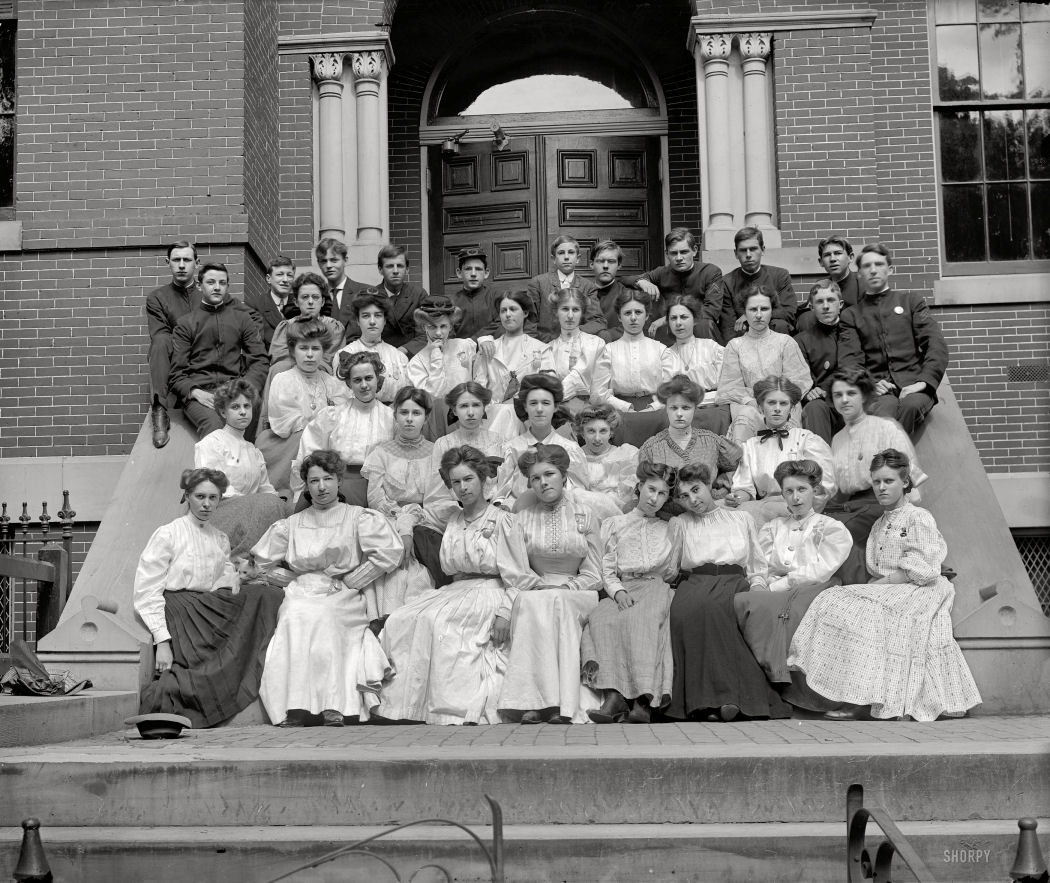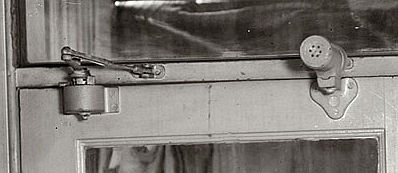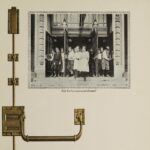[I added an update at the bottom of this post!]
Today I ran across a couple of photos of an unidentified piece of hardware on an amazing photography blog – Shorpy.com. The site contains thousands of high definition photos, most from between 1850 and 1950. The images are so detailed I could explore them for hours. But back to reality…
There are two photos on the site that include a piece of hardware that I’ve never seen in person (the piece of hardware beside the closer). I did see the bottom portion still attached to a door somewhere in my travels, but I didn’t know what it was for. If you know, tell me! If you don’t know, send this post to someone who might.
Here are the photos, and the close-ups are below them. You can click on either of the complete images to view them full size on Shorpy.com.
UPDATE: Although quite a few people thought this was some type of horn or door chime, I received several comments and lots of emails that confirmed that it is a “snugger,” (not to be confused with a Snuggie, as noted by @SurveillanceCow). The closer in the photos is just a spring – nothing to control the door. The snugger assisted with the latching portion of the closing cycle.
I received the first comment from Jess the Door Doctor, and subsequent comments and emails from others including Donald and Liz at Liz’s Antique Hardware, and Maud Eastwood, the author of 150 Years of Builders’ Hardware: Forms, Use & Lore, and Antique Builders’ Hardware, Knobs & Accessories.
Best of all, one of my own team-mates, John Gant, has been holding out on me. He knew where some of these “snuggers” were installed on classroom doors in a school that’s being renovated. I asked if he could get me one, and with one email to the architect I’ve been promised a snugger of my very own.
According to my stats for yesterday and today, you dig antique hardware! I think I should start including periodic posts on it!
You need to login or register to bookmark/favorite this content.









It looks to me to be some kind of door buzzer or mechanical entry buzzer.
door chime????
Hi Lori
My guess is that it is some type of annunciator. Think of the kids’ toy that makes the cow sound “MOO.” It is a canister with holes on one end and baffles inside. When you tip the canister, air rushes in, which vibrates the baffle, causing the sound to be produced. Did the bracket you saw on a frame have anything sticking out, that might act as a plunger to operate the baffles?
The tin ceiling, oversized water heater, closer on the door, etc indicates to me that this is a commercial or institutional establishment. If this is an annunciator, it would want to be loud enough to hear if you were in another room. That’s my guess and I’m sticking to it.
Jim
[Note from Lori: I withheld all of the comments with the correct answer to give people time to guess, so this comment was not visible until midnight of 12/9.]
ahhhhhh………….i have seen these on ebay rarely, these were what closers looked like before the traditional potbelly closers were made.
the ones featured in the pictures i believe were made by Eclipse, the part with arm, that was spring, the cylinder thing, that was only to prevent slamming, it basically worked on a snap-shut closing (not controlled closing like today’s closers) because the closer was not dampened until last few inches of closing (latch) when door is opened, the cylinder came apart (piston came out of the cylinder)
these were the days when a door closer was called a door closer AND check, the closer was the spring part (part with arm) and check was that cylinder that dampened the latch. these were not really all that adjustable accept the spring tension (like with any traditional closer, the gear thing at top under the arm (called a ratchet)
later on (1880’s when Lewis C. Norton made his invention) the spring and piston were combined into one unit, both the spring and dampening in one unit which resembled that of a large bore screen door closer but with an arm connecting from the piston rod to the door.
this has been by far the oldest of door closers pictures i have see here, great find Lori! hopefully next time i see an early norton (1880’s before rack and pinion or traditional potbelly closers came out) on ebay, hopefully I’ll win.
Make this a contest, and Jess will win with flying colours! *verybiggrin*
[Note from Lori: I withheld all of the comments with the correct answer to give people time to guess, so this comment was not visible until midnight of 12/9.]
I would guess some sort of closing dampener. The closer looks to be just a spring in a housing. It probably wind up when the door is opened and unwinds when closing. Note the holes on the end of the “dampener”. I would think the air in the cylinder is forced through these holes as the door closes and forces some sort of plunger in the cylinder. Need to find an old fart AHC to confirm this product!
[Note from Lori: I withheld all of the comments with the correct answer to give people time to guess, so this comment was not visible until midnight of 12/9.]
It looks to me like some kind of dampener so the door closer doesn’t slam the door???
That looks like my Grandmother. But, yeah, I agree that it’s some sort of horn. Those photos are amazing. I’ll be spending some time on that site too. Thanks.
[Note from Lori: I withheld all of the comments with the correct answer to give people time to guess, so this comment was not visible until midnight of 12/9.]
I asked our production VP who used to be an installer and this is what he came up with:
I am thinking an assist to the latch speed. The closing speed and latch speed may have failed on the closer and this was installed to prevent the door from slamming.
Lori, I guess I’m a bit late to the game. I agree that its a horn. Possibly some type of inflated diaphragm inside the cylinder that is depressed by the frame portion and as the door opens the diaphragm sucks air in and pulls it through some sounder. I don’t think its designed on the mooing toy design but more on a reverse whoopie cushion. Who knows? Love the fact the closer is on the outside of the building too. Guess the installer didn’t order the angle bracket to set the closer into the opening.
[Note from Lori: I withheld all of the comments with the correct answer to give people time to guess, so this comment was not visible until midnight of 12/9.]
It is a pneumatic damper. The closer and damper we sold as a set. The closer is just a spring and would slam the door shut. If the picture showed the door in the open position there would be a post sticking out from the frame portion of the damper. When the closer closes the door the post presses into the portion on the door which contains a compression spring, leather packing, and most likely a valve to regulate the air escaping through the holes that are visible. This would be the latch function on door closers now. The same damper system is in use today on a commercial walk in fridges. The link below is for the newer type in use now. Very cool pictures.
http://www.o-reps.com/id151.html
John R, nice to see you posted here, you are REALLY close and yes it is the mechanical latch damper
i don’t think these had the spring in them, from a patent about them i seen long ago (f, it was basically the piston and cylinder without a spring, the piston was on end of the post that is on frame portion of the cushioning device (you were really close john) this just basically did nothing but cushioned and had some form of control over the latch of the door, the fridge closers in the link, I have seen smaller version used on closet doors in the classrooms of the middle school, they have the spring assist in it bringing the door tight to the frame (because of gasket material in the case of a walk-in refrigerator)
Rachel: it was a part of the closer installation, it was not a fix to a failed closer, the closer you see in the photos is JUST A SPRING and did not do anything more then what a spring hinge does (slam the door shut, a snap shut type closer) this just dampened the last final few inches of door closing
Lori: that’s great your going to get your own snugger soon, really pays off to catch a school in renovation doesn’t it?) when you get it, I hope you can upload pictures to show us your new hardware.
antique hardware, for me, I love seeing old antique door closers, I know that (from what I have heard) there is antique closers on display in the Lock Museum of America in CT. closest oldest one I get to see (older then 1952) is one of my screen door closers,(no idea what year, but it’s pneumatic) and other oldest one is at the animal hospital, a traditional closer from 1932 as told by the British vet I take my dog to.
It’s actually operating opposite of the way a modern closer works then. Now we have a slow swing speed and faster latch speed. That set-up would smack you in the back side but have a nice gentle finish.
The snugger we’re providing to Lori is marked SARGENT ECLIPSE 1623 and PAT. FEB 28.1886
Must have been cutting edge stuff back then as the school was built in 1885. 🙂
Nice detective work there folks….great site!
John, I knew it!! I can just look at a door closer and tell you the brand (and series) and the decade it was made in, (my nickname of doordoctor wasn’t given to me for nothing)
I remember eclipse because of the door closer half (spring with arm) I remember a plenty of them being sold on eBay over the last 5 years and didn’t know that they actually were a product of Sargent.
yes those snuggers were cutting edge technology back then in the world of door control, was either that or a snap shut slamming spring hinge.
that’s pretty cool, i have a Sargent screen door closer, no idea of the year that Sargent made screen door closers, but have a feeling it was made pre-1930’s. would be interesting to find out, I guess the lock museum of America would know or someone who has to do with historic (pre-1900’s) hardware would know.
how I immediately knew what it was, Google patents+strong interest in door closers/hardware+many hours at the computer= finding interesting hardware and help identifying around the time the hardware was patented.
oldest of hardware any of my schools I have attended, had I remember was some old traditional 1954(i think) russwin size C or D, it was used on their boiler room door. another school they had a 60’s Corbin, (model 131, another boiler room door closer)
I’m pretty sure Lori cannot wait for her snugger to arrive and will happily take pride in owning a piece of historic hardware from the school. wonder how many snuggers remain at the school and if not, were did the rest of them go?(hopefully not to a scrapyard, they are too much of a treasured peice of hisotry to just toss out)
as for upgrading door hardware on schools, STICK WITH LCN (if you look in the archives for the post cracker barrel shocker, you will see why I always push for schools to use LCN or an ingersoll rand grade 1 closer instead of an aluminum glorified soda can (other brands)
-Jess the door(closer)doctor
Yes, you are right. this appears to be a snugger. still found on some old doors particularly in Asian countries. I remember seeing similar ones installed but not exactly same. never tried to explore them but now after reading your blog, will definitely explore them a bit more..;-)! thanks!
~Raheel
globalmetal.company
I’m hoping there are some that can help me revive this thread a moment.
My family and I recently closed on a 1907 home in Kentucky. It has quickly become a treasure trove of research for me. I love history.
During our first tour, the item here: https://photos.app.goo.gl/r7uvGrrDu8iFfPf38
was hanging on the inside of the front door. Long story short, this blog posting, is the CLOSEST bit of information I can find related to this picture. After reading all of your posts, I understand that it is a “snugger” or “check” meant to keep the door from slamming shut.
I was also able to find a Sargent catalog from 1926 listing this type of item under a “Closer, Door” on page 650 of 1074 in the document.
https://archive.org/details/Bryce_201807/page/n649/mode/2up
Of course, the model numbers shown in this catalog are 1623, 1625, and 1627 while mine is stamped 1225 or 1226 (difficult to tell with all the layers of paint).
Beyond the catalog listing and your blog posting, the trail goes cold. Even AI can’t find further information.
Is there anyone here with more information or can point me to a different tunnel in the rabbit hole 🙂
I’d really like to date this piece, remove it for restoration, and reinstall even if only to add character.
That’s so cool, Cheston – I love history too! Would it be ok if I shared your photos in a new post and asked if people had any more info?
– Lori
Absolutely Lori, thank you.
Interestingly I just came across a painted over crank doorbell on the same door. I’ll have to send you pictures of that, as well.
It would be great if you could send all of the photos to my email – lori.greene@allegion.com. Thanks!
– Lori